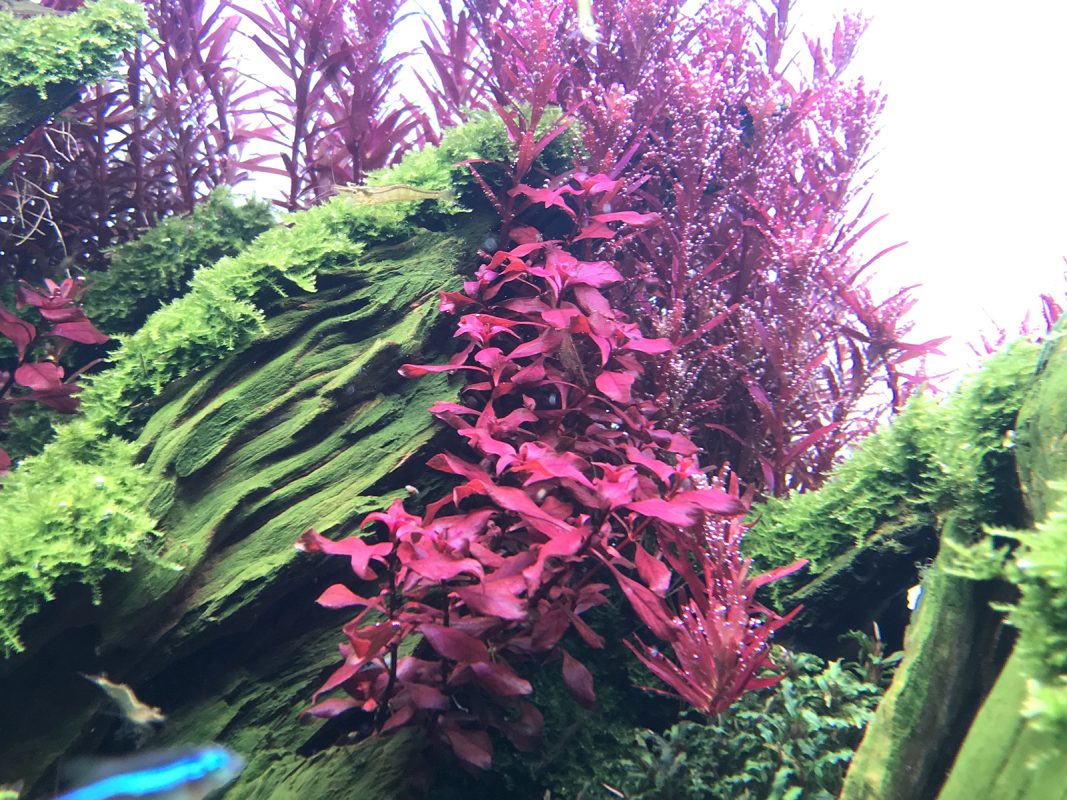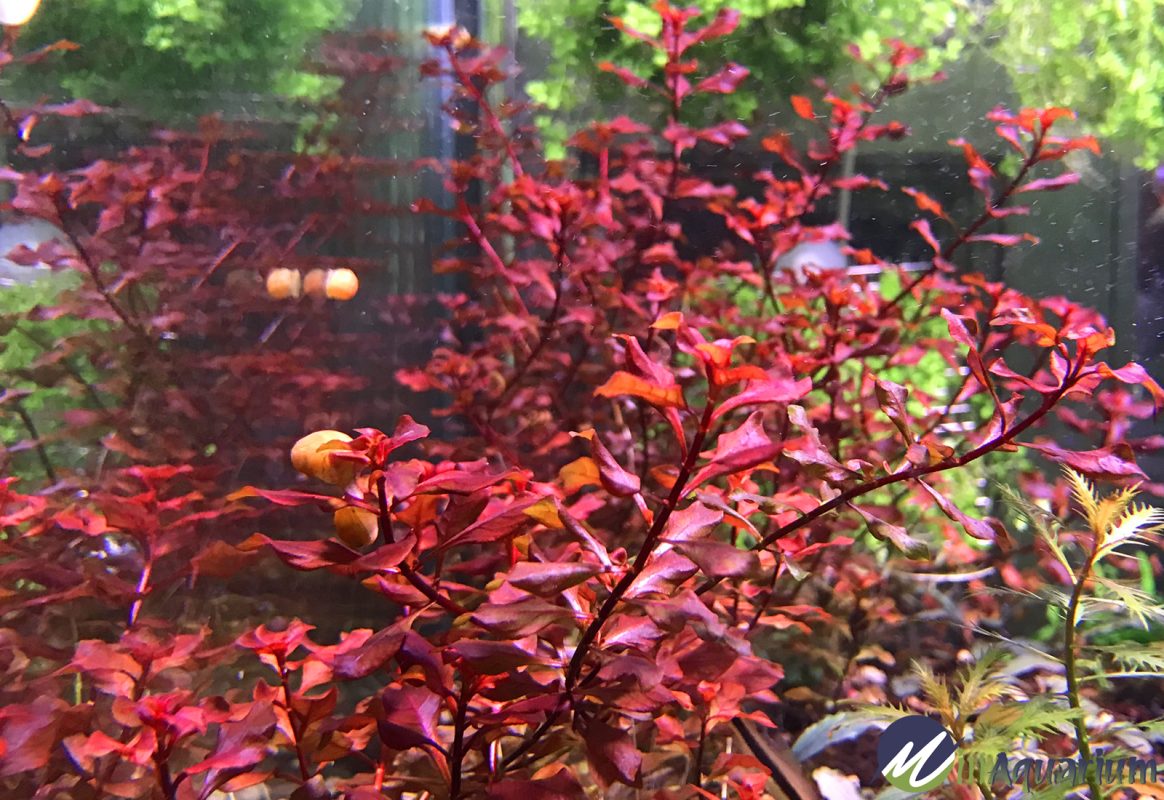Blogs
Ludwigia Palustris Super Red – A Comprehensive Guide to Care, Propagation, and Coloration
Scientific Classification
At the intersection of beauty and biology lies the Ludwigia palustris ‘Super Red’, an aquatic plant celebrated for its striking appearance and ease of care. Scientifically classified within the family Onagraceae, the genus Ludwigia, and the species Ludwigia palustris, this particular cultivar stands out prominently for its stunning red foliage.
Origin and Distribution
The natural habitat of Ludwigia palustris ‘Super Red’ spans broad geographical terrains. Originating from Eurasia, North, and Central America, this versatile plant thrives effortlessly in wet to flooded environments such as marshes. Its adaptability allows it to flourish across the United States, where it is also known colloquially as marsh seedbox or water purslane. This wide distribution highlights its resilience and pliability in diverse ecological settings.
Appearance and Characteristics
Ludwigia palustris ‘Super Red’ is distinguished by its submersed and emersed growth forms. Each stalk can achieve a height of 10-30 cm and a width of 2-4 cm. The leaves, elliptical in shape, exhibit a captivating gradient from ruby on the upper side to dark ruby underneath. This red intensity makes it a standout piece in any aquatic garden. Compared to its cousin, Ludwigia repens ‘Rubin’, this plant is characterized by smaller leaves and a slightly slower growth rate. However, unlike other varieties, achieving that glorious red hue is possible even under medium lighting conditions, cementing it as an ideal highlight plant.
Growth Habit
The allure of Ludwigia palustris ‘Super Red’ is not merely in its color but also in its vigorous growth habit. Fast-growing by nature, this plant readily produces side shoots, especially when trimmed, encouraging a dense and bushy appearance. It is this propensity for propagation through cutting that makes it a darling among aquarium enthusiasts. Easily establishing new roots upon replanting, it ensures that a vibrant display is maintained throughout the year. Commonly positioned in the middle ground and background of aquarium layouts, it enhances the depth and allure of aquatic sceneries.
Aquarium Care

Lighting Requirements
One of the key factors influencing the success of Ludwigia palustris ‘Super Red’ in an aquarium is lighting. This plant demands medium to bright lighting conditions to thrive. A consistent exposure of 8-10 hours of moderate lighting daily can significantly promote its growth, while also enhancing the vibrancy of its red foliage. For aquarists aiming for the most intense red color, bright lighting combined with CO2 injection is necessary. However, balancing light levels is critical, as extremely high lighting can trigger unwanted algae growth, which will require additional measures to manage.
Water Parameters
Another vital aspect of nurturing Ludwigia palustris ‘Super Red’ is maintaining suitable water parameters. The plant thrives best in slightly acidic to neutral water, with an ideal pH range of 6.5 to 7.5. It adapts to various temperatures but shows optimal growth at a range of 59-86°F (15-30°C). This wide temperature tolerance underscores its adaptability, making it a suitable inhabitant for most home aquariums. Providing adequate nutrients in both water and substrate is crucial to prevent deficiencies that can manifest as yellowing or melting leaves—symptoms often seen when nutrient levels are suboptimal.
Substrate and Fertilization
To maximize the health and visual appeal of Ludwigia palustris ‘Super Red’, an appropriate substrate and effective fertilization regimen are imperative. The plant thrives in a nutrient-rich substrate; substrates such as Seachem Fluorite, Carib Sea Eco-Complete, and Fluval Plant & Shrimp Stratum are excellent choices. Regular fertilization helps in maintaining robust growth and vibrant coloration. Supplements of macro and micronutrients, especially iron, should be consistently administered. This ensures that the plant receives the necessary nutrition to sustain its striking red color and liveliness.
CO2 Injection
Although Ludwigia palustris ‘Super Red’ can grow without CO2 injection, the benefits of incorporating CO2 cannot be overstated. CO2 injection can significantly accelerate growth and intensify the red coloration of the leaves. A CO2 concentration of 20-40 mg/L is recommended for optimal results. This added CO2 supplies the plant with an enhanced ability to photosynthesize efficiently, promoting healthier and faster growth. For aquarists who aim to achieve the deepest, most vibrant red hues, CO2 injection is almost indispensable.
Temperature
Maintaining an ideal temperature is crucial for the well-being of Ludwigia palustris ‘Super Red’. As earlier noted, the plant thrives in a temperature range of 59-86°F (15-30°C). This broad temperature tolerance reflects its native origins from Eurasia and the Americas, where varying climates are commonplace. However, maintaining a stable temperature within this range is key to avoiding stress that could potentially hinder growth or lead to unwanted issues like leaf melting. For most home aquariums, this temperature range is easily achievable with standard heating systems.
Propagation

Stem Cuttings
Propagating Ludwigia palustris ‘Super Red’ through stem cuttings is a straightforward process that underscores the plant’s simplicity and adaptability. To propagate, one simply needs to trim stems at least 3 cm from the top, ensuring to include nodes where new growth can emerge. When planted into the substrate, these cuttings quickly establish new roots. Bury the stems about 1-2 inches deep with the top 2-3 cm remaining above the substrate. This ensures the cuttings access light and nutrients efficiently while fostering new root growth at a rapid pace.
Side Shoots
A fascinating aspect of Ludwigia palustris ‘Super Red’ is its robust ability to generate side shoots, particularly when trimmed. Cutting back the stems not only facilitates propagation but also induces the mother plant to produce numerous side shoots. This response results in a thicker, bushier appearance—making the original plant visually strong and healthy. For optimal propagation, the side shoots can be cut and replanted in bunches of 5-6, enhancing the density and lushness of the aquarium layout.
Placement and Use
Midground and Background
The placement of Ludwigia palustris ‘Super Red’ within an aquarium setting significantly impacts the overall aesthetics of the aquascape. Given its height potential of up to 30 cm (11.8 inches), this plant is ideally suited for the midground and background positions. Its tall, upright growth habit makes it a perfect candidate for adding vertical interest and depth. When strategically positioned, it not only elevates the beauty of the aquarium but also provides a natural habitat for small fish and invertebrates.
Contrast and Color
One of the most compelling features of Ludwigia palustris ‘Super Red’ is its ability to provide striking color contrasts within an aquarium. Its vivid red leaves stand out starkly against the more commonly green aquatic plants, creating an eye-catching visual effect. The thin stems and pointed leaves of the plant also contribute to its elegant, almost flowing appearance, which lends a sense of movement to the aquascape. This plant’s versatility in color and form makes it an invaluable addition to a well-planned aquarium.
Aquascaping Applications
In the realm of aquascaping, Ludwigia palustris ‘Super Red’ is a versatile gem. Its vibrant coloration makes it ideal for creating focal points that draw the viewer’s eye. Whether used as a backdrop for green stem plants like Rotala rotundifolia or contrasting species such as Cryptocoryne spp., it enhances the overall visual appeal. The plant’s fast growth rate and ease of propagation also make it practical for those who wish to experiment with layout designs. Trimmings from propagations can be re-used or shared, deepening communal bond among aquarium hobbyists.
Troubleshooting
Yellowing Leaves
Yellowing leaves in Ludwigia palustris ‘Super Red’ generally indicate a nutrient deficiency, particularly of iron. An effective remedy involves increasing the iron dosage in the fertilizer regimen by around 50% and closely monitoring the plant over the following three weeks for improvements. Hard water conditions can exacerbate iron uptake issues; thus, considering the use of iron chelates with strong binding agents may also be beneficial. Regular checks are advisable to ensure the plant is not experiencing persistent nutrient stress.
Melting Leaves
Melting or rotting leaves present a more complex challenge but are often tied to deficiencies in nutrients, suboptimal lighting, or inadequate CO2 levels. Ensuring a balanced supply of macronutrients such as nitrogen, phosphorus, and potassium, through a comprehensive EI dosing regimen, is essential. Lighting needs to be sufficient to prevent lower leaves from melting, with moderate to high light levels being ideal. Proper CO2 distribution and stable levels are also pivotal in preventing leaf melting, promoting healthy growth instead.
Green Leaves
Occasionally, Ludwigia palustris ‘Super Red’ may develop green leaves, indicating insufficient lighting. Younger plants especially may initially have green leaves before transitioning to the desired red hue. Ensuring bright lighting levels is key to maintaining the plant’s characteristic red coloration. Adjustments in light intensity can mitigate this issue, underscoring the importance of monitoring and adapting care practices to the plant’s needs.
Benefits
Easy Maintenance
Ludwigia palustris ‘Super Red’ shines as an easy-to-care-for plant, making it a top choice for both novice and experienced aquarium enthusiasts. Its capacity to thrive under a range of lighting conditions, from low to medium levels, offers flexibility in tank setups. Moreover, it does not necessitate high levels of CO2 or intensive fertilization, paving the way for simplified maintenance. The plant’s rapid growth rate enables it to quickly colonize spaces, providing immediate visual interest and enhancing the overall aquarium ecosystem. Propagation is a breeze, adding to its appeal.
Vibrant Red Color
The plant’s most striking asset is its vibrant red color, which dominates with ease in an aquatic environment. This hue is relatively easy to achieve compared to other species, making Ludwigia palustris ‘Super Red’ methodically rewarding. When subjected to bright lighting and CO2 supplementation, the plant’s leaves and stems turn an even deeper red, enhancing its visual impact. This striking color attracts not only the seasoned plant keepers but also those looking to add a bold statement to their aquatic scenery.
Fast Growth Rate
The fast growth rate of Ludwigia palustris ‘Super Red’ contributes to its popularity. Standard care and conditions will already see it thriving, but optimal environments with plentiful nutrients, sufficient light, and CO2 supplementation can further accelerate its growth. This rapid propagation means that a few plants can quickly transform into a lush, carpeted section of the aquarium, aiding both visual fullness and biological filtration within the tank.
Aesthetic Appeal
Incorporating Ludwigia palustris ‘Super Red’ can dramatically elevate an aquarium’s aesthetic appeal. Its intense red coloration, when paired with the contrasting greens of other flora, creates a picturesque underwater landscape. This plant bridges the gap between color and form, offering both aesthetic value and ecological benefits. It’s a testament to how the right plant can turn a simple aquarium into a dynamic, ever-evolving piece of living art.
In conclusion, Ludwigia palustris ‘Super Red’ serves not only as a vibrant focal point but also delivers practicality and ease of care. It stands out in the world of aquascaping for its stunning red coloration, fast growth, and minimal maintenance requirements, making it a beloved plant among aquarists in the United States.

